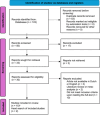Sleep-Related Breathing Disorders and Lower Urinary Tract Dysfunction in Children and Adolescents: A Scoping Review
- PMID: 39760418
- PMCID: PMC11788972
- DOI: 10.1002/nau.25652
Sleep-Related Breathing Disorders and Lower Urinary Tract Dysfunction in Children and Adolescents: A Scoping Review
Abstract
Aims: Sleep disordered breathing (SDB), lower urinary tract dysfunction (LUTD), and enuresis (NE) are common in children and adolescents and have serious consequences, especially on social and emotional development. Even though much is known about the association between SDB and NE among adults, the number of articles in children and adolescents is limited. Therefore, the aim of the present scoping review was to map out the current knowledge about SDB and LUTD in children and adolescents.
Methods: Four electronic databases (i.e., Embase, PsychInfo, Pubmed, Web of Science) were searched in accordance with the Johanna Briggs Institute (JBI) manual for Evidence Synthesis1 and the Preferred Reporting Items for Systematic Reviews and Meta-Analyses extension for scoping reviews (PRISMA-ScR).2 The Quality Assessment Tool for Quantitative Studies (QATQS) was used to evaluate the methodological quality of the included studies.63,64 All articles in this scoping review met the following inclusion criteria: (a) the sample included children/adolescents between the ages of 5 and 18; (b) there was a presence of both LUTD and (a clinical manifestation of) SDB, (c) the article was published in English and/or Dutch; (d) the article was available in full text. The following exclusion criteria were used: (a) studies with solely one of the two main concepts (e.g., LUTD or SRBD); (b) studies with a third variable, other than treatment-oriented variables; (c) articles published in a language other than English or Dutch; (d) meta-analyses and reviews.
Results: The search resulted in the inclusion of 17 articles related to SDB and LUTD in children and adolescents. Even though all included articles found a clear association between SDB and NE in children, very limited information was found on SDB and other LUTS and/or how the association impacts children and adolescents with developmental delays (DD's). In addition, limited and/or conflicting results were found related to SDB, NE and other variables (e.g., family history of NE, obstructive sleep apnea (OSA) severity, gender, preoperative ADH/BNP levels, obesity and ADHD). An adenotonsillectomy (T&A) had a significant beneficial therapeutic effect on NE in children and adolescents with SDB.
Conclusions: This scoping review found a clear association between SDB/OSA and NE, as the arousability and urine production at night are impacted. T&A could be considered as a treatment option for children and adolescents who do not respond to standard NE treatment. However, more research is needed to determine mechanisms involved in responders and non-responders and to examine the possible association between SDB in children and adolescents with other LUTS and/or developmental delays. The need for a multidisciplinary approach and future research is highlighted to provide children and adolescents with comorbid disorders adequate care based on the understanding of underlying conditions and mechanisms involved.
Keywords: adolescents; children; developmental delays—scoping review; enuresis; lower urinary tract dysfunction‐incontinence; obstructive sleep apnea; sleep‐related beathing disorders.
© 2025 The Author(s). Neurourology and Urodynamics published by Wiley Periodicals LLC.
Conflict of interest statement
The authors declare no conflicts of interest.
Figures

Similar articles
-
The association between obstructive sleep apnea and nocturnal enuresis in children: current advances and research trends.World J Urol. 2025 Mar 10;43(1):158. doi: 10.1007/s00345-025-05541-4. World J Urol. 2025. PMID: 40064684 Review.
-
Adenotonsillectomy Normalizes Hormones and Urinary Electrolytes in Children With Nocturnal Enuresis and Sleep-Disordered Breathing.Urology. 2015 Jul;86(1):158-61. doi: 10.1016/j.urology.2015.04.011. Urology. 2015. PMID: 26142600 Clinical Trial.
-
Impact of adenotonsillectomy on nocturnal enuresis in children with sleep-disordered breathing: A prospective study.Laryngoscope. 2016 May;126(5):1241-5. doi: 10.1002/lary.25934. Epub 2016 Mar 1. Laryngoscope. 2016. PMID: 26928519
-
Attention deficit hyperactivity disorder and sleep disordered breathing in pediatric populations: a meta-analysis.Sleep Med Rev. 2014 Aug;18(4):349-56. doi: 10.1016/j.smrv.2013.12.003. Epub 2013 Dec 24. Sleep Med Rev. 2014. PMID: 24581717
-
The role of adenotonsillectomy in the treatment of primary nocturnal enuresis in children: A systematic review.J Pediatr Urol. 2018 Feb;14(1):53.e1-53.e8. doi: 10.1016/j.jpurol.2017.07.016. Epub 2017 Sep 6. J Pediatr Urol. 2018. PMID: 28986091
Cited by
-
The association between obstructive sleep apnea and nocturnal enuresis in children: current advances and research trends.World J Urol. 2025 Mar 10;43(1):158. doi: 10.1007/s00345-025-05541-4. World J Urol. 2025. PMID: 40064684 Review.
References
-
- de Wall L. L., Nieuwhof‐Leppink A. J., van de Wetering E. H. M., et al., “Study Protocol for a Parallel‐Group Randomized Controlled Multi‐Center Trial Evaluating the Additional Effect of Continuous Ultrasound Bladder Monitoring in Urotherapy for Children With Functional Daytime Urinary Incontinence (SENS‐U Trial),” Trials 23, no. 1 (2022): 648, 10.1186/s13063-022-06600-6. - DOI - PMC - PubMed
-
- von Gontard A., “The Impact of DSM‐5 and Guidelines for Assessment and Treatment of Elimination Disorders,” European Child & Adolescent Psychiatry 22 (2013): 61–67. - PubMed
Publication types
MeSH terms
Grants and funding
LinkOut - more resources
Full Text Sources
Medical
Miscellaneous

